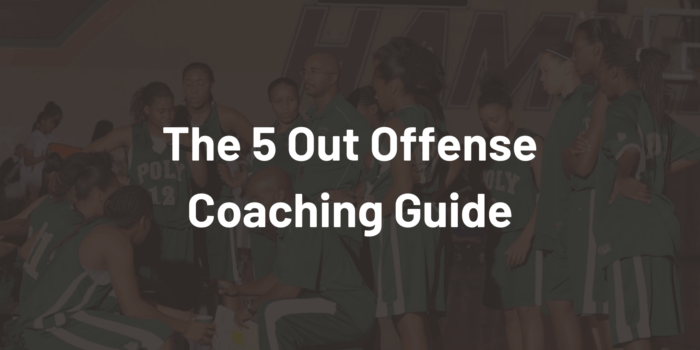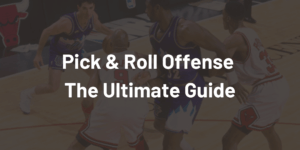As basketball is shifting towards "positionless basketball", 5-out offenses are getting more and more popular. In this offense, all five players position themselves behind the 3-point line, creating a stark departure from traditional basketball strategies:
- 5-out encourages great spacing and provides the offense with a lot of dribble penetration opportunities.
- There is no traditional center or interior player hovering around the basket. Each player is expected to be able to skillfully shoot, pass, dribble the basketball.
- The Five Out offense can be played on every level of basketball and can be adapted to be as simple or complex as needed.
- It can be run as a base offense, your sole offense, or in quick hitter situations.
- It can be run against man defense or zone defense.
- It can flow from your transition and be run as something conceptual after plays break down.
In this guide, you will discover the ins and outs of the 5-out offense, including its basics, advanced strategies, as well as its advantages and downsides.
Basics of the 5-Out Offense
The beauty of the 5-Out Offense is that it can be taught to any level of basketball player - from beginning youth players to experienced pros. The basics of the offense promote good, fundamentally sound, high-quality, and aesthetically pleasing basketball.
Before we dive into the concepts, here are a few rules to keep in mind:
- Every time a player catches the ball, they should be facing the rim, looking at the rim, and passing to an open cutter (if available)
- Every time a player passes the ball, they should cut HARD to the rim as if they were trying to score
- There are no backward cuts - once you cut, finish your cut all the way to the rim. If you are denied, go to the rim. No backward cuts!
- Do not be a robot. This will vary depending on your team. If you have an experienced team that can make reads, it will sometimes be tempting for your players to just “run the play” instead of taking advantage of defensive mishaps. Encourage your team to run the offense but to also hunt advantages to score. If you have a very inexperienced team, you might encourage them to just run the motion until it becomes second nature and/or they improve their skill set.
- Follow the rules! If one player starts to wander aimlessly or cut out of turn, it jams up the whole timing and flow of the offense
1. Pass, Cut & Fill
- The first and most basic rule of the 5-Out Offense is that when you pass, you must basket cut - every single time! As players develop, a coach may want to add rules or give options to this but, in the beginning, this rule must be followed to the letter.
- After a pass, the player who passed the ball must basket cut hard to the rim. An important teaching point here is that players should be “cutting to score”. Players must cut every time as if they might get the ball back for a layup (and sometimes they will). This puts more pressure on the defense and the rim. It will also open up the floor for better spacing.
- Once a player cuts to the rim, the other players fill the empty spots
- This movement becomes a habit pretty quickly because it makes sense. Just cut to the open spot next to you.
- Now, the original cutter simply fills into the open spot.
- You could literally run this as your entire offense - especially on a youth level - if you wanted to.
- 1 passes to 2
- 1 cuts hard to the rim, looking for the give-and-go for a layup
- 2 fills the next open spot
- 4 replaces 2
- 1 replaces 4
- We are now back into the 5-out format and the motion continues
- 3 passes to 2
- 3 cuts to the rim
- 5 fills the empty spot
- 3 replaces 5
- The motion continues from here
2. If You Are Overplayed, Go Backdoor
- If a player is cutting towards the ball but finds themselves denied by the defense, they must go backdoor.
- This cut is now just like the cut a player would make after passing to a teammate.
- The cutter cuts all the way to the rim, the other players fill, and the cutter goes to the open spot.
- Once a player decides to cut backdoor, they must finish their cut. Remember, no backward cuts or coming back to the ball. Once you cut, you cut!
- 3, 5, and 1 are all filling their new spots
- x3 denies 3 the reversal pass
- instead of going backwards or standing still, 3 immediately goes backdoor and looks for the layup
- If the pass is not there, the 5-Out motion continues from here on
3. If Your Teammate Dribbles At You, Go Backdoor
- If a player with the ball dribbles at you, you must go backdoor.
- Just like the backdoor cut mentioned above, the same rules for a normal basket cut apply here: cut all the way through, cut and fill to next spot, other players rotate to open spot
- Players must understand the difference between their teammates driving and attacking the rim and dribbling at them
- A north and south dribble to the rim is a drive
- An east and west dribble to the side is a dribble at
- A good rule here would be that if a player dribbles directly at you and they are above the 3-point line, go backdoor.
- 1 dribbles at 3
- 3 goes backdoor
- 1 looks to pass to 3 for a layup
- If the pass is not there - 2, 4, and 3 all fill into their appropriate spots
- Now, the offense continues using the 5-Out rules
4. If a Teammate Drives, the Other Players Rotate the Direction of the Drive
- On a drive inside the 3 point line (not a “dribble at”), the players will rotate in the direction the ball was driven.
- For instance, if the ball is dribbled right, players all move one spot to their right. If the ball is dribbled left, players all move one spot to their left.
- If you are in the corner and the ball is dribbled right, you are cutting to the rim.
- On a kickout, the passer basket cuts after their pass - just like they would do with any other pass.
- The other players now rotate and fill the empty spots.
- 2 drives right into the paint - therefore, everyone else rotates to the right
- 5, since there is nowhere on the right to go to, cuts baseline. This may look like it causes traffic but it actually provides solid backdoor opportunities and clears out space for 2 to get to the other side of the rim
- 3, 1, and 4 all cut right
- If 2 kicks it out, the offense then goes back to 5-Out Rules
- 4 and 5 fill up to the next spots
- This leaves one spot for 2 to fill into
- Now, the offense continues
With those 4 basic “rules”, you can teach this offense to any level of basketball player or team. As a coach, you’ll want to make sure your players have mastered the previous rule before advancing to the next one.
Do not overload them with the entire offense at once! Teach it it in progressions, master each step, and then add on as you see fit. This will vary based on the experience level, age, and talent of your team.
If your team has these basic rules down (and you want to), you can progress to more advanced rules, concepts, and strategies.
Advanced Rules, Concepts, and Strategies
1. Off Ball Screens
- You can add a rule that states: once the ball is passed, the passer must set a screen away from the ball.
- The cutter who uses the screen now becomes the cutter to the rim and the same basic rules apply.
- When first installing this, it might be wise for the coach to instruct the player who is receiving the screen to always curl tight to the rim. Once this is mastered, the coach can give more freedom to the players to make their own reads and reactions (popping, flaring, rejecting the screen, slips, etc.)
- 1 passes to 3
- Instead of cutting to the rim, 1 screens for 2
- 2 curls tight to the rim
- Since 2 curled to the rim, 1 comes back to the ball/rotates to the proper spot
- 4 and 2 also rotate to the appropriate spots
- Now, we are back into the 5-Out Offense
- 3 passes to 5
- 3 screens away for 1
- 1 cuts outside and cuts to the ball
- This means 3 will now cut inside (we always want a rim cut)
- 3 cuts to the rim
- 2 and 4 fill their spots
- 3 fills the next open spot
- We are back into 5-Out
2. Ball Screens / Pick & Rolls
- Another rule you could add involves ball screens. A coach could instruct their players to follow their pass and go set a ball screen. This could be an option within the offense or a specific automatic action for certain players on the roster (post players, for example)
- A roll to the rim would act just like any other basket cut in the aforementioned rules
- 5 passes to 3
- 5 follows their pass and sets a ball screen for 3
- 5 rolls to the rim (a basket cut)
- 3 dribbles and makes a read
- 1 rotates
- 5 rotates
- Now we are back into our 5-Out alignment
3. Post-Up Opportunities
- Getting post-up opportunities for your players might be a little tricky within the 5-Out offense. However, with a little creativity you can find ways to get the ball inside.
- For example, when a player basket cuts they could post up at the rim instead of empty out to the open spot they would normally fill.
- Another option could be executing a dribble at that sends a teammate backdoor. Instead of cutting all the way through, they turn and seal to look for a pass inside.
- These options could be play calls or reads made by players
- 1 passes to 3
- 1 cuts to the rim
- Instead of emptying out, they attempt to seal their defender and try to get a post feed
- This is what it looks like when 1 is posting up
- If 1 can't receive the pass, everyone rotates like usual
- Another option is to use a dribble-at to post up
- 3 dribbles at 5
- 5 cuts to the rim, but then turns to seal their defender and get a post feed
- 3 looks to pass to 5 in the post
4. Quick Hitters
5-Out doesn’t have to solely be motion offense or concept-based offense. You can also run specific plays out of the 5-Out (or adapt your current plays into 5-Out sets).
Here are three examples:
5 Out Flex is a quick hitter to get flex action out of 5-Out.
- 1 passes to 3
- 1 cuts to the rim (if they are open, pass to them)
- 1 continues their cut to set a "flex screen" for 4
- 4 uses the screen
- 3 looks for 4
- After 1 screens for 4, 2 then screens for 1
- 1 pops out and looks for the shot
- 2 also might be open if their defender helps on 1's cut
- Now you can continue Flex action, back it out into 5 out, or do whatever else you want your offense to do
5 Out Stagger is a simple double screen set out of the 5-Out alignment
- 1 passes to 3
- 1 and 2 screen away for 4
- 4 comes off the screens looking to receive the pass
- 4 can pop OR curl to the rim
- 2 slips to the rim and 1 pops out
- Now you can flow into whatever offense you want or back into 5-Out
5 Out Flares uses flare screens (and slips) on both sides of the floor to spring players open.
- The ball starts on the wing
- 3 passes to 1
- The corner players (4 and 5) set flare screens on the wings (2 and 3)
- 4 slips to the rim; 5 pops
- If there are no open players, your team can flow into 5-Out
5. Common Offenses Converted into 5-Out
Coaches also have the option of converting their typical man-to-man offense (or traditional and popular offenses) into 5-Out.
Here are some examples:
5 Out Flex is a quick hitter to get flex action out of 5-Out.
- 1 passes to 3
- 1 cuts to the rim (if they are open, pass to them)
- 1 continues their cut to set a "flex screen" for 4
- 4 uses the screen
- 3 looks for 4
- After 1 screens for 4, 2 then screens for 1
- 1 pops out and looks for the shot
- 2 also might be open if their defender helps on 1's cut
- Now you can continue Flex action, back it out into 5 out, or do whatever else you want your offense to do
Here's one way to convert the Dribble Drive Offense into 5-Out Principles.
- 1 drives to the rim
- Everyone cuts in the direction the ball moves
- 1 kicks out to 3
- 2, 4, and 5 rotate to the next open spots
- 1 fills out to the only open spot (the corner in this example)
- 3 reverses to 2
- 2 looks to drive
- The offense continues
This is an adaptation of principles from the Princeton Point Offense into 5-Out Offense
- 1 passes to 3
- 1 screens away for 2
- 2 rejects the screen and goes backdoor (classic Princeton action)
- 1 opens up to the ball (this will sometimes be open for a shot)
- 2 empties out; 5 fills in next spot
- 3 reverses to 1
- 3 sets ballscreen for 1
- 3 rolls; 4 replaces
- 3 finishes cut to the rim and now we are basically into 5-Out again
6. Common Actions Converted into 5-Out
Just like coaches can convert their base offenses to 5-Out, they can take certain offensive concepts and convert them to 5-Out.
Just because you run 5-Out, it doesn’t mean you can’t run continuity ball screen principles, zoom action, ghost screens, etc. A little creativity, like mentioned before, goes a long way to make this work within the 5-Out Offense.
7. Five Out Transition Offense
You can maintain your 5-Out spacing in transition as well. Coaches have a few options in this department:
- Run lanes to 5-Out positions - players sprint the floor in the same lanes they’ll end up in the half court (both corners, wings, middle)
- Have a rim runner sprint to the rim and then empty out to a corner
8. Zone Offense
The 5-Out principles can also be applied to zone offense. Coaches have options here as well:
- Run the same actions and just cut through the lane and fill gaps.
or
- Instead of cutting all the way through, have players “button hook” cut into a gap for a second to occupy the high post. As soon as they see they are not getting the ball, they leave the high post and cut to the open spot they would have in the base man-to-man offense. Players continue to move the ball until they find an opening.
9. Running a Roles-Based 5 Out Offense
- This is a more advanced version of the offense that would require your players to have a lot of experience both as basketball players and within a specific system…but would be very difficult to defend or prepare for.
- In this version of 5-Out, you give each of your players a rule.
- For example:
- Player A always sets ballscreens after reversing the ball. Player B always screens away. Player C and Player D always just pass and cut. Player E can choose to do whatever they think is best.
- Giving each player a specific rule/rules to follow allows the coach to utilize players and their strengths in unique ways.
Advantages of the 5-Out Offense
1. Your team will improve over the course of the season
- With this offense, each player plays every position, they learn every spot on the floor, and they get a lot of repetitions in every part of the offense.
- Over the course of a season full of practices and games, they’ll become better basketball players simply by running this easy-to-learn offense.
- Eventually, you’ll have 5 players on the floor at a time who understand the basics of basketball.
2. It can be adapted to skill and experience levels
- This is one of the main reasons the offense is so popular. It’s easy to install and quick to be understood.
- I’ve seen 3rd grade youth girls run the offense and teams on the international professional level run the offense.
- You can adapt it however you want to meet your needs as a coach and give your team the best chance at success!
3. You can convert most offensive basketball concepts/trends into 5-out
See something during March Madness that catches your eye and you’d like to try to use with your team? Really love Princeton but want to transition to 5-Out? You can take just about any concept you see and adapt it to 5-Out (see more on this later in the post).
4. Keeps everyone involved
- This is especially beneficial at the youth level.
- Everyone gets to touch the ball, everyone gets to move (no sticking kids in the corner), everyone gets to feel a part of the team.
5. It’s unpredictable for opposing defenses
- Yes, the main pattern is fairly predictable. But eventually, as they learn it, the defense will always be wrong.
- Opposing defenses can not adequately prepare for what they do not know is coming!
6. Can play to each player’s advantages with role defining
As mentioned above, you can give each player their own roles to fill. The higher the basketball IQ and skill level, the more responsibilities and choices you can give your players.
Disadvantages of the 5-Out Offense
Random or “equal opportunity” offense can be tricky
As a coach, you might not want every player on the floor to handle the ball, make decisions, or be trusted with the ball. You can counter this by offering specific instructions for each player, but it’s hard to avoid a specific player from being put in a decision-making situation.
Your best players don’t always have the ball
If you have a few better skilled players and you’d prefer the ball in their hands, it can sometimes be left up to chance with the randomness of the offense. Any efficient offense works to get their best players the highest quality of shots. There’s potential to lose that at times with the 5-Out.
The lane can get clogged up
Players that are 2-3 passes away from the ball on defense can start to really cheat into the lane. It’s a long pass from a wing to an opposite corner and defenders can start to help off their matchup to prevent any driving lanes.
Players play robotic and become too predictable.
Sometimes, players will just go through the motions of passing, cutting, and filling without really looking to attack. When this happens, smart and pressuring defenses can begin to jump passing lanes, pressure the ball, and anticipate the offense’s next move rather easily.
It’s more difficult to get post touches.
Even if you run specific sets and actions for players with post skills, it can sometimes be difficult to get them touches out of the flow of this offense. Since it is so perimeter oriented, this is often overlooked as a legitimate option for teams.
What Types of Teams Should Use the 5 Out Offense?
This offense is good for teams on any level, but there are also certain types of teams that it would be most beneficial for.
Some teams that would benefit from the 5-Out offense are:
1. Youth basketball teams
5-Out is a great base offense, it teaches fundamentals of timing, cutting, passing, screening, and spacing, and it allows everyone to be a part of the offensive gameplan. The more everyone is involved, the more repetitions players get in making good basketball decisions. The more decisions they make, the better they
2. Smaller teams
Teams with smaller rosters can expose bigger and slower defenders by spreading the floor in the 5-Out. They can also pull big defenders that occupy the paint out beyond the perimeter.
3. Teams with interchangeable parts
If a team has multiple players that can be play similar positions and have similar skills, this offense can cater to them very easily.
4. Teams with shooters and ball handlers
Just like with any offense, if a team has players who can shoot and handle the ball, the offense is going to run optimally.
5. Teams that rep it out!
All you need to do to get good with the 5-Out offense is practice it with consistency and intentionality. Commit to it and it will be good to you and your team

Founder of thehoopsgeek.com. A passionate basketball enthusiast and coding geek, Andy combines a love for sports with technology.








